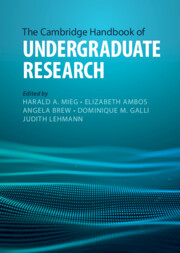Book contents
- The Cambridge Handbook of Undergraduate Research
- The Cambridge Handbook of Undergraduate Research
- Copyright page
- Contents
- Figures
- Tables
- Contributors
- Foreword
- Foreword
- 1 Introduction
- Part I Theory and Research on Undergraduate Research
- Part II Implementation, Approaches, Methods
- Part III Disciplines
- 17 Introduction
- Part III.1 STEM
- Part III.2 Health
- 24 Undergraduate Research in Medicine
- 25 Undergraduate Research in Health Sciences
- 26 Undergraduate Research in Nursing
- 27 Undergraduate Research in the Exercise Science Discipline
- Part III.3 Social Sciences
- Part III.4 Humanities
- Part III.5 Arts & Design
- Part III.6 Disciplines A–Z
- Part IV International Perspective
- Part V Avenues for Developing Undergraduate Research
- Index
- References
25 - Undergraduate Research in Health Sciences
from Part III.2 - Health
Published online by Cambridge University Press: 11 August 2022
- The Cambridge Handbook of Undergraduate Research
- The Cambridge Handbook of Undergraduate Research
- Copyright page
- Contents
- Figures
- Tables
- Contributors
- Foreword
- Foreword
- 1 Introduction
- Part I Theory and Research on Undergraduate Research
- Part II Implementation, Approaches, Methods
- Part III Disciplines
- 17 Introduction
- Part III.1 STEM
- Part III.2 Health
- 24 Undergraduate Research in Medicine
- 25 Undergraduate Research in Health Sciences
- 26 Undergraduate Research in Nursing
- 27 Undergraduate Research in the Exercise Science Discipline
- Part III.3 Social Sciences
- Part III.4 Humanities
- Part III.5 Arts & Design
- Part III.6 Disciplines A–Z
- Part IV International Perspective
- Part V Avenues for Developing Undergraduate Research
- Index
- References
Summary
Although health science disciplines may implement an element of research in the curriculum, the primary focus has been on learning clinical practice and the creation of safe practitioners. Examples of best practice include early implementation of research in the undergraduate curriculum, scaffolding, and collaboration. In order to improve practices related to undergraduate research in the health sciences, it is important to address the needs and developments required. These needs include changing the perceptions of the value of undergraduate research for both students and faculty, finding ways to add undergraduate research to an already full and potentially overwhelming curriculum, addressing the institutional barriers that prevent undergraduate research from occurring, and reducing barriers related to faculty experience and time constraints.
Keywords
- Type
- Chapter
- Information
- The Cambridge Handbook of Undergraduate Research , pp. 250 - 257Publisher: Cambridge University PressPrint publication year: 2022



